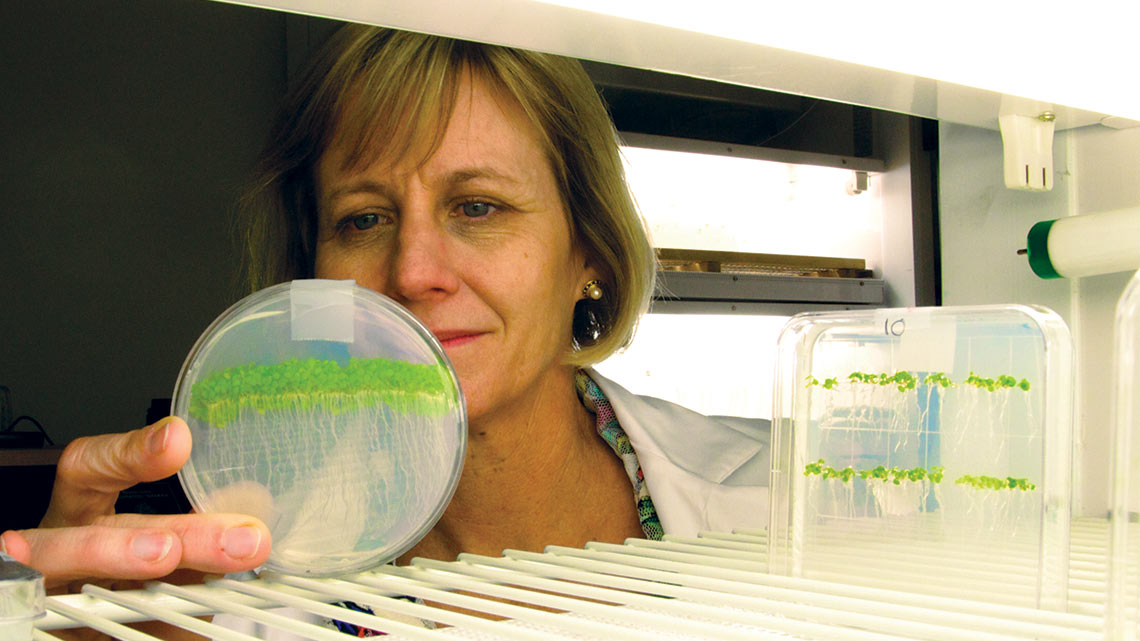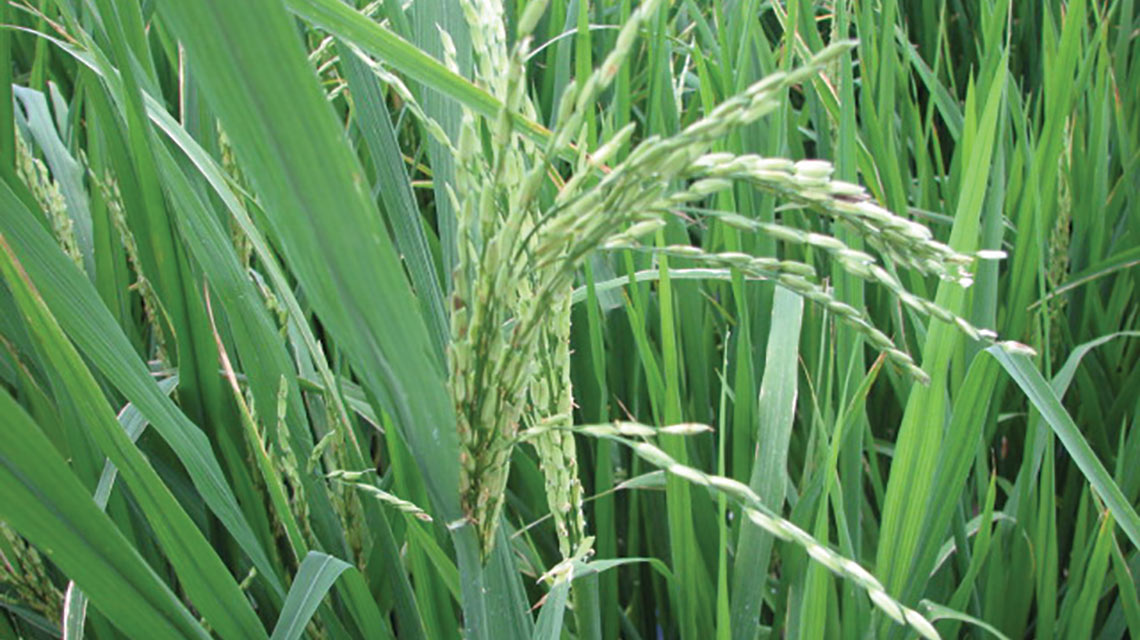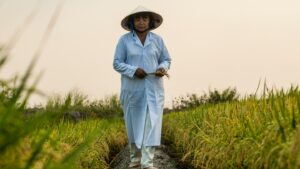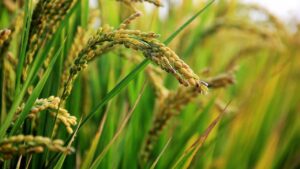What researchers learn from a specific rice gene could one day help to reduce crop damage from flooding that occurs after planting.
is a writer, blogger and social media specialist. She grew up near Sedalia, Missouri, where her family owns and manages a large cattle and grain operation. In 2011, she moved to the Kansas City area with her husband, and now enjoys writing about agriculture.
Understanding the genetics of various seed characteristics can uncover a new world of potential for stress-tolerant crops. Some of the biggest advances on this front involve the development of “flood-proof” rice.
Although traditional rice varieties are grown in wet paddies, the plant is intolerant of complete submergence for more than four days. In areas where flooding is common, such as Bangladesh and India, submergence causes an estimated annual economic loss of more than $600 million, according to the International Rice Research Institute.
However, in recent years, new rice varieties have been developed to combat these conditions. The first of these, Swarna-Sub1, developed by David Mackill, a University of California, Davis, geneticist and other scientists, began to be used by rice farmers in 2008. Now, more than 10 million farmers have grown this particular rice variety and have been able to avoid complete crop losses when monsoons and floods dump too much water.
When flood conditions are not present, Swarna-Sub1 performs the same as the first-generation Swarna variety.
The development of Swarna-Sub1 was made possible by Kenong Xu who identified a single gene on rice chromosome 9 called SUB1A. Xu was mentored by Mackill, when he worked at IRRI, and Pamela Ronald, a University of California, Davis, professor of plant pathology. This particular gene and the form that enables survival of monsoon floods is present in some traditional rice varieties grown in flood-prone areas of India and Bangladesh.
Today, Julia Bailey-Serres, a University of California, Riverside, professor of genetics, is working with other colleagues at the Center for Plant Cell Biology and IRRI to learn more about how this gene works, as well as how it can be applied to other agricultural issues.
“They are calling it the next Green Revolution,” Bailey-Serres says. “It’s remarkable the impact this has in helping farmers who grow rice in flood-prone areas, which is about 35 percent of all rice production.”
The primary focus of Bailey-Serres’ work is to define the specific mechanisms of conducting signals that are critical to the plant’s response when faced with less than optimal growing conditions. “The reason we’re studying this is because the particular gene has already been identified and bred into farmer-preferred varieties in addition to Swarna,” she says. “But genes don’t work in a vacuum. We want to understand what this gene does at a cellular level in various stages of the plant when it is in stress — not just during a flood but after a flood.”
For example, Bailey-Serres’ team works to better understand what happens at a molecular level when cells are deprived of oxygen during floods. “We have uncovered low oxygen-sensing and response mechanisms that enable survival for a short period of oxygen deprivation,” she says.
The team has also found other beneficial applications for this gene.
The SUB1A gene won’t completely protect a plant from drought, but the same gene that allows the plant to tolerate submergence has been shown to activate in situations where the plant is without water.
“The plant will still suffer from the drought, but it will recover better than varieties without the gene,” Bailey-Serres says.
During the production of rice, the seed is germinated and the seedlings are then transplanted to wet paddies. Because of this, IRRI is trying to formulate rice varieties that will germinate successfully from seed while submerged yet still maintain their ability to go dormant when submerged later as a seedling.
Eliminating this step would make the planting process much more efficient.
This is an especially difficult project. Bailey-Serres says the challenge comes from attempting to create a seed that will germinate and grow rapidly while underwater, but then go dormant when submerged as an older plant — two contradicting goals.
“You’re asking the plant to do opposing things, one early on and one later in its life cycle,” she says. “It’s very tricky, but it seems like there are genetic solutions; that’s an area we’re working on.”
Finding a solution for rapid germination that is independent and doesn’t overlap in function with SUB1A gene will give farmers a better chance to establish a rice crop by direct seeding that can also endure submergence later in life.
In the U.S., these developments in rice aren’t necessarily being used because most American-grown rice is farmed in controlled environments with irrigation systems built on modern technology.
However, Bailey-Serres says that no negative effects from adding the SUB1A gene to U.S.-grown rice are known.
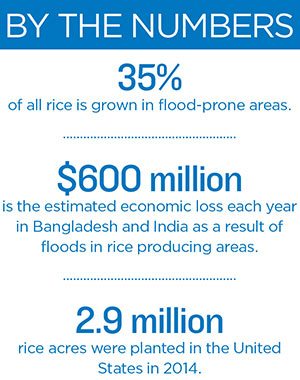
And, Bailey-Serres says the technology doesn’t make the seeds more expensive because there are no licensing fees. “It wasn’t developed with the intention of commercial gain so there aren’t really any restrictions to moving the gene around into new varieties,” she says, noting that as an advantage of working with IRRI.
Considering the wide range of plant stresses faced by farmers, ranging from floods to droughts, disease and other concerns, the potential applications for better understanding the stress-response gene characteristics seem endless, especially when expanding the research outside of rice. For example, Bailey-Serres says the U.S. faces extensive damage each year to corn seedlings that are flooded out early in the season.
“Maize does horribly when submerged; it dies within two or three days,” she says.
Currently, researchers are learning about how specific traits of a gene allow a plant to survive submergence for an extended number of days. However, Bailey-Serres says there are no research projects to-date devoted to transitioning those genes to corn.
Typically, funding and support for seed development projects comes directly from seed companies that want to offer their customers a better-performing seed. But when early corn crops are flooded out, insurance companies often pay farmers to replant using new seed, which could increase seed sales. This cycle doesn’t create the necessary motivation for seed companies to fund the research to develop submergence-tolerant corn.
“Flooding costs a lot in damage and lost crops each year, so the biggest question is why we aren’t working on this in the United States,” Bailey-Serres says. “Perhaps this is an opportunity.
“I think the work we’ve done in understanding the SUB1A gene could be of value in helping develop submergence-tolerant maize.”
In the meantime, Bailey-Serres believes it’s important for researchers to understand as much as possible about the gene. The long-term goal is to increase crop tolerance for agricultural stress-triggers, combine those stress tolerances to develop hardier varieties, and to contribute to the general understanding of low-oxygen and gene regulation in plant cells.
“When a particular solution is deployed, we want to understand how and why it works,” she says. “This will allow us to use those benefits to their full potential.”


